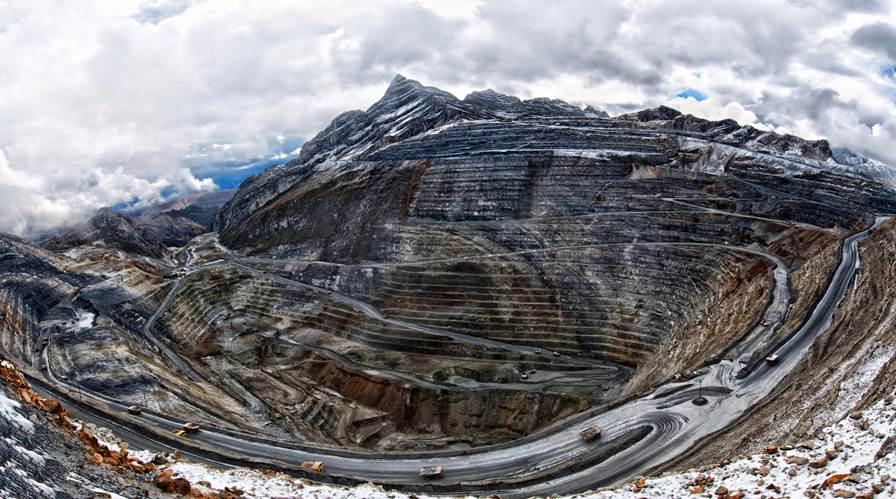
Antamina mine, Peru. Image from Glencore.
https://www.mining.com/featured-article/bullish-investors-add-90bn-to-top-50-biggest-mining-companies/?utm_source=Daily_Digest&utm_medium=email&utm_campaign=MNG-DIGESTS&utm_content=bullish-investors-add-90bn-to-top-50-biggest-mining-companies
The MINING.COM Top 50* most valuable mining companies pared much of the losses suffered in the third quarter, adding a combined $86.3 billion in market capitalization over the final three months of 2021, as investors in the sector position for what should be another strong year for the industry.
After peaking mid-year, the total value of the top 50 ended 2021 at just under $1.4 trillion, up around $100 billion since the start of the year and double the market capitalization during March/April 2020 at the height of the pandemic.
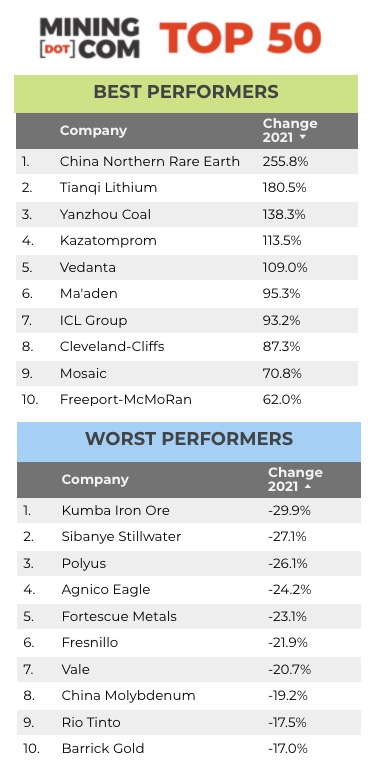
Iron will
The Big 3 – BHP, Rio Tinto and Vale – dragged down the index last year, losing a combined $56 billion over the year as the pullback in iron ore prices and a cooling copper market in the latter part of 2021 hammered valuations at the top.
BHP peaked at a valuation of just shy of $200 billion last year, and for a time was worth more than the oil major Royal Dutch Shell, making it the most valuable stock in the UK.
It is an indication of the belief investors have in the effect on mining of the green energy transition or GET™. That BHP gave up nearly $50 billion subsequently (Rio Tinto lost $43 billion since its peak) despite burnishing its battery metals credential with its pursuit of nickel assets is also an indication that iron ore remains the bread and butter of the industry.
Iron ore’s waning fortunes also saw Kumba Iron Ore of South Africa emerge as the worst performer for the year, with a 30% plunge in the stock. The world’s no. 4 producer Fortescue Metals Group gave up almost $13 billion of its market worth over the course of the year and dropped six spots on the ranking as its Fortescue Future Industries arm gets off to a slow start.
With the iron ore market in retreat, Brazil’s CSN Mineração, one of the biggest mining IPOs since Glencore in 2011 when it debuted in Q1, fell out of the top 50, but thanks to an 87% surge last year, Cleveland-Cliffs looks secure in the top 50 for now after spending years in the wilderness.
Lithium lift
Lithium prices have extended their year-long rally as electric car demand motors along and the three producers in the top 50 now have collective value of over $66 billion.
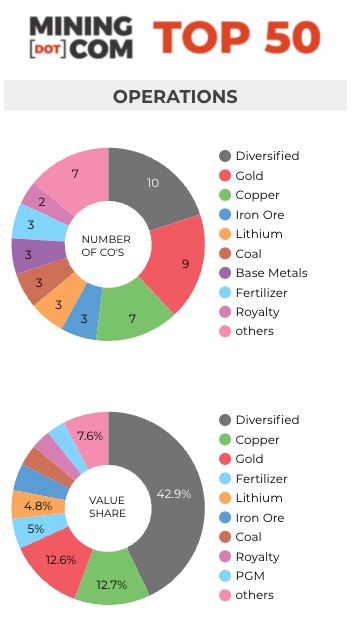
Tianqi Lithium briefly fell out of the ranking at the end of 2019 as its market value fell below $5 billion, but the Shenzhen-listed producer has now pierced the top 20, surpassing SQM in the process, with a value of some $25 billion.
The world’s number one producer, Albemarle, is up 59% since the start of the year making its investors a cool $10 billion richer. The Charlotte-North Carolina company in September announced it’s buying a Chinese lithium processor in efforts to expand downstream.
Lithium is becoming a crowded market.
While Rio Tinto’s Jadar project is off to a rocky start in Serbia, the Anglo-Australian giant’s lithium business would probably start showing up in valuations in coming years as would Sibanye’s move into the battery metal with an acquisition in Nevada.
Top lithium chemicals manufacturer Ganfeng (excluded here because mining is a minor part of its business) is desperate for upstream investment and copper giant Codelco is bringing forward work on its lithium project, but other concessions in Chile may become scarcer or cease altogether.
Also look out for Pilbara Minerals to join the top 50 in the not too distant future, as the stock continues to set record highs and the company’s Pilgangoora operations ramp up to supply booming demand for spodumene from Chinese converters. At today’s valuation, Pilbara Minerals would occupy position number 54.
Coal crown
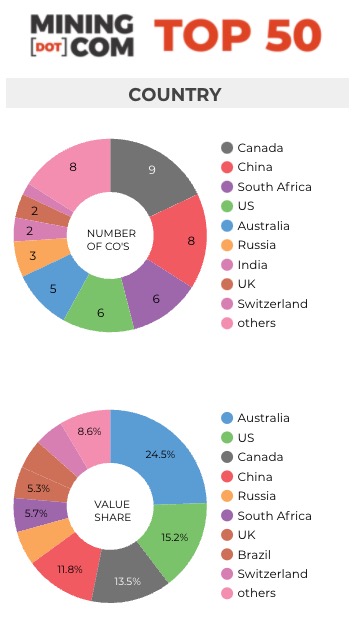
With no exposure to iron ore other than trading, Glencore bucked the trend, and investors in the Swiss commodities giant ended the year a collective $25 billion richer. Glencore has not abandoned coal mining, like its peers and and its coal, gas and oil trading arm is benefiting from sky high prices for energy.
Evidence of the volatility of commodities markets is the performance of coal miners, especially in China, in 2021. Although some air escaped the sector towards the end of the year not long ago, coal miners (and coal divisions at diversifieds) looked set to disappear from the ranking altogether.
The value of the three remaining coal companies (the ranking excludes power utilities such as Shenhua Energy that operate their own mines) surged and Coal India finally arrested its decline. Four years ago the world’s largest coal miner made it to no 4.
Uranium upside
Thanks to a rally in the nuclear fuel a decade in the making since the Fukushima disaster, uranium stocks rejoin the top 50 ranking for the first time in many years.
The value of Kazakhstan’s Kazatomprom, which has expanded its exchange listings well beyond Almaty, more than doubled this year, and turmoil in the country responsible for some 40% of global uranium output has, so far, not affected the state-controlled company’s fortunes.
Top rival Cameco was just pipped by AngloGold Ashanti and does not appear in the end-year top 50 although relative share price performance since the close on December 31 would have the Saskatoon-based company firmly back in the ranking on hopes it can capitalize on a revived uranium market and Kazakh troubles.
*NOTES:
Source: MINING.COM, Miningintelligence, Morningstar, GoogleFinance, company reports. Trading data from primary-listed exchange where applicable at close Dec 31 2021, currency cross-rates Jan 7 2022.
Percentage change based on US$ market cap difference, not share price in local currency.
Market capitalization calculated at primary exchange, where applicable, from total shares outstanding, not only free-floating shares.
As with any ranking, criteria for inclusion are contentious issues. We decided to exclude unlisted and state-owned enterprises at the outset due to a lack of information. That, of course, excludes giants like Chile’s Codelco, Uzbekistan’s Navoi Mining, which owns the world’s largest gold mine, Eurochem, a major potash firm, Singapore-based trader Trafigura, and a number of entities in China and developing countries around the world.
Another central criterion was the depth of involvement in the industry before an enterprise can rightfully be called a mining company.
For instance, should smelter companies or commodity traders that own minority stakes in mining assets be included, especially if these investments have no operational component or warrant a seat on the board?
This is a common structure in Asia and excluding these types of companies removed well-known names like Japan’s Marubeni and Mitsui, Korea Zinc and Chile’s Copec.
Levels of operational or strategic involvement and size of shareholding were another central consideration. Do streaming and royalty companies that receive metals from mining operations without shareholding qualify or are they just specialized financing vehicles? We included Franco Nevada, Royal Gold, and Wheaton Precious Metals.
Vertically integrated concerns like Alcoa and energy companies such as Shenhua Energy where power, ports and railways make up a large portion of revenues pose a problem as do diversified companies such as Anglo American with separately listed majority-owned subsidiaries. We’ve included Angloplat in the ranking as well as Kumba Iron Ore.
Many steelmakers own and often operate iron ore and other metal mines, but in the interest of balance and diversity we excluded the steel industry, and with that many companies that have substantial mining assets including giants like ArcelorMittal, Magnitogorsk, Ternium, Baosteel and many others.
Head office refers to operational headquarters wherever applicable, for example, BHP and Rio Tinto are shown as Melbourne, Australia but Antofagasta is the exception that proves the rule. We consider the company’s HQ to be in London, where it has been listed since the late 1800s.
Please let us know of any errors, omissions, deletions or additions to the ranking or suggest a different methodology:
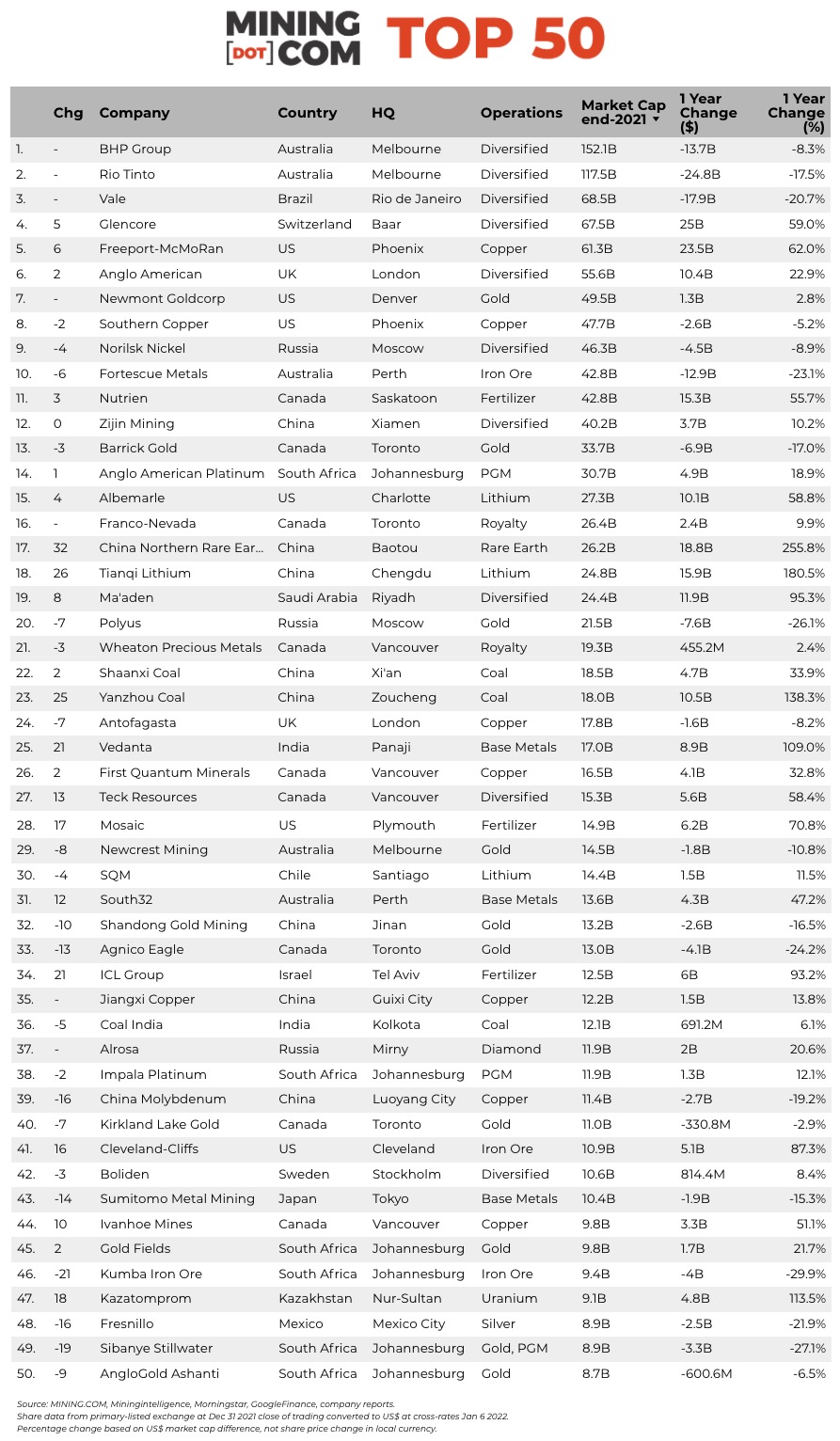
No comments:
Post a Comment